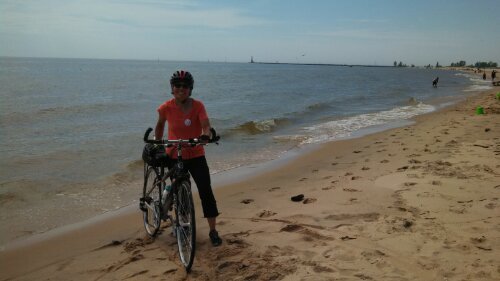It’s Day One of the 2013 PALM and we’re camped out on the grounds of a local middle school in Norton Shores on the west side of the state. One semi broke down so some people are still waiting for their bikes to arrive but many of us have already ridden out to the beach to perform the ritual of dipping your rear tire in Lake Michigan. Six days from now we will hopefully put the front tire in Lake Erie at the ride’s end.
All the cyclists are friendly and helpful and immediately make newbies like me feel welcome.
Next on the agenda is dinner and the nightly meeting. Each night on the ride, classes will also be offered in everything from bike safety basics to routine maintenance. They’re presented by Al Lauland, a veteran of 15 PALM rides and a certified League of American Bicyclists cycling instructor.
The intro class is Traffic 101 to make sure that every PALM rider knows the rules of the road.
“There is a very common misconception among motorists that bikes should not be on the road. If we had some education going on maybe that could change,” said Lauland. “Bikes fare best when they act and are treated as vehicles. In my estimation the Number One component to making Michigan more bike-friendly is to get vehicles educated on how to share the road with bikes and educate cyclists on how to share the road with cars.”
I’ve already experienced that firsthand today, sadly. We were turning left at a traffic light obeying the rules of the road just like we were supposed to when a driver yelled out his window, “Get those bikes out of the road!”
Not exactly what you’d call bike-friendly, right?
Michigan took a giant step forward with bikeability in 2010 by enacting Complete Streets legislation calling for roadways designed to be accessible for all legal users including cars, trucks, mass transit, wheelchair users, bicyclists, and pedestrians. Many communities are starting to pass local ordinances and implement plans to incorporate Complete Streets concepts into their roadways.
But all the Complete Streets policies in the world won’t actually make those roads safer if all these user groups aren’t properly educated in how to safely and legally use and share all that shiny new infrastructure.
Conversely, good bicycle safety education can go a very long ways toward making cyclists safer even on existing roadways in current traffic conditions.
I was reminded of this a few days before the ride started when I was out riding near my neighborhood. A mom, dad and their two kids were out on a family bike ride. We all smiled and waved, and they looked like they were having a wonderful time. Both kids were wearing helmets. Mom and dad were wearing baseball caps: an unspoken but powerful message that protecting your brain is for babies and helmets are to be shed as soon as you’re old enough to be “cool.”
Then I watched them turn out onto the two-lane blacktop, all four of them pedaling along on the wrong side of the road directly into oncoming traffic.
These weren’t bad or careless parents. Not at all. What they were is uneducated. And that is a problem that Lauland says is getting worse, not better.
“I used to do many presentations in elementary schools. But except for a couple schools that incorporate it into their phys ed programs, I can’t even get in anymore. They can’t justify bicycle safety instruction because it’s not part of the dictated curriculum that’s all about MEAP scores,” said Lauland. “I’ve also tried getting a half hour to talk to driver’s ed students on how to interact with cyclists on the road. But it seems all the school districts use third parties for driver’s ed now and they all have their own curriculum and are not interested in me being as part of it. And there is nothing on the driver’s test related to it.”
Route planner Gary Kenyon agreed.
“Education is by far the single biggest thing we’re lacking from grade school on up. It’s nonexistent. Even police sometimes don’t know the laws,” said Kenyon. “That’s why there has got to be an education component to any new piece of legislation related to cycling.”
But at least right now, for this particular group of 800-plus riders, we’ve got access to a free first-class education in all things bicycling. And I plan to take advantage of it.
“There are some people I see in my beginner rider class year after year. I swear I’m their nightly entertainment,” said Lauland, chuckling. “That’s a good thing, right?”
[/fusion_text][/fusion_builder_column][/fusion_builder_row][/fusion_builder_container]